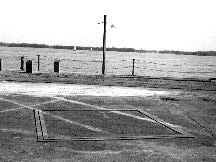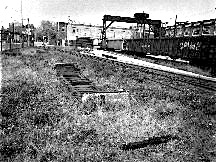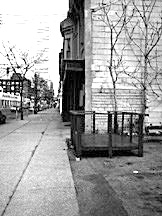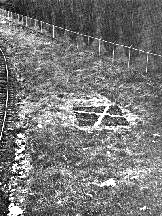- MAIN INDEX | ARTIST INDEX
| May 15 - June 30, 1980 LOCATIONS II
| |
 James Taciuk, installation view of "Cuts", 1980. Photo Peter MacCallum. 18K |  Lee Pacquette, installation view of "Untitled", 1980. Photo Peter MacCallum. 18K |
 Robert Bowers, installation view of "Public Work", 1980. Photo Peter MacCallum. 18K |  Peter Blendell, Bathurst St. Bridge installation, 1980. Photo Peter MacCallum. 18K |
|
LOCATIONS Introduction by Peter Hill, Michael Balfe: In past years there has been an increasing awareness of the fact that there are many limiting and neutralising factors inherent in the gallery space which alter the original context of most artists' work. This perception has been noted by such seminal artists as Robert Smithson, Dennis Oppenheim and Daniel Buren during the last decade. It was this concern that led to a number of developments as to where a work should appear and how it should relate to its place. There are two basic attitudes which seem to be readily apparent. One can make work for a gallery space which heightens awareness of its location within a particular interior/context; or, work can be located at a specific outdoor/exterior site that is inseparable from the concept or the criteria of the work itself. It was with attention and interest in these attitudes that MERCER UNION put together LOCATIONS: OUTDOOR WORKS BY TORONTO ARTISTS last summer. While several artists in Toronto had been involved with site-specific works for some time, the LOCATIONS exhibition also provided an opportunity for other artists to address the broad issues of context, materials and entropy in the undifferentiated urban environment. The response and results of last year's show gave momentum and foresight to the current exhibition, and this year MERCER UNION was able to make available funds to the artists involved in the desire to eliminate problems of securing locations and materials. By the very nature of its concept, the exhibition presents various hurdles which must be straddled in the fabrication and display of these works. For the artists there are challenges in finding and securing locations in a city of suspicious landlords and nervous politicians. Robert Bowers decided to rent a spot in the parking lot beside his studio while others approached City Hall seeking permission to use vacant city-owned property. Still others chanced endurance by locating their pieces without securing any permission whatsoever. Unsolicited alteration and removal of works last year was not uncommon. In a show of this nature, the viewer is not without his problems also. As specific as the locations are, the recognition of the work in that site is not always immediate nor obvious. Most are fairly recognisable by their counter action to the location. Others, by their very close association to the location, become so much a part of it that recognition is the main criteria for its existence. A third aspect of viewer dilemma relates to the physical placement of the locations in terrain where the search requires athletic ability or ventures into areas where normal traffic is prohibited. Thus, the varied attitudes and interests of these artists, cross-referenced with their choices of locations and techniques, results in a wide assortment of visual experiences for the active viewer. Several pieces have developed from the viewpoint of information processes. Andy Patton and Peter Dykhuis both use a poster format to involve themselves with presenting process of information, context and duration. Stan Denniston coordinates a photographic view of a Vancouver skyline with a respective Toronto panorama. H. P. Marti took his interest in information exchange and mailed post cards of his chosen site to the MERCER UNION mailing list and close friends. Brian Groombridge and Lee Pacquette made use of the situation to talk about visual metaphor. Groombridge's link-fence xerox construction on an Adelaide Street construction wall creates a harmonic metaphor between abstraction and fact. The tar and snow-fence construction of Lee Pacquette has connotations of suspended train trestles or simply the train track it sits beside. Some works also pay attention to more sociopolitical topics. Michael Amar wrapped a lead wire around a tree, seemingly to recognise the effect of environmental relations to social change; the coil expands as the tree grows larger. The Campbell piece is an architectural alteration of a house's front porch on St. Patrick Square alluding to concerns of history and style. Then there is the small kiosk on King Street built by Caroline Simmons that invites the viewer to enter and add graffiti to the chalk-board walls inside. There are also ventures into areas connected and bounded by prefabricated markers. Dan Reid subtly maps a square by placing four cast steel cornerstones in an open field of steel-coloured sand. Another square is laid out by Taciuk's incisions cut into the concrete surface and framed by plate steel on the Harbourfront York Quay dock area. Definition of location is also handled by Robert Bowers, who built a platform at the side of his studio in a parking lot. His work sets the stage for future events or presents a viewing station for passers-by. Lastly, there is that group of artists which by means of their involvement with the LOCATIONS show define the work and its location by relationships to the intrinsic physical properties of the site. Peter Blendell's piece is coordinated by aligning the corners of adjacent buildings within a rectangle that echoes a larger relationship. The beam placed by Robin Peck is a proportional mass which represents a scaled reduction of the volume of the underpass it sits in. Robert McNealy triangulates the history of his involvement with the LOCATIONS shows using MERCER UNION as the base angle. And at the foot of Parliament Street, Colin Lochhead locates his piece by internally bounding an area with scaled models representing physical aspects of his location, and placed in relationships that map the area in context to its surroundings. As you can see, the attitudes, techniques and locations of the work are extremely broad and cannot, in most cases, be summed up by way of a catalogue introduction. It is the intention of MERCER UNION that this catalogue remain only as a record of events and locations since it is another context which is distanced from the artists' concepts. It is not meant to be a passive substitute for an active experience.
PETER BLENDELL Co-ordinate point 4 833 020 North 321 750 East in Zone 17 of the Universal Transverse Mercator Projection System. Elevation 77.3 meters. The Universal Transverse Mercator Projection System was developed by the military during World War II to meet its need for a standardised, precise mapping system. It has since been adopted by NATO and most western countries, including Canada. This projection is generated by dividing the surface of the earth between the parallels 80 degrees North and 80 degrees South into 60 zones, each of 6 degrees longitude. The zones are numbered 1-60, beginning with the zone bisected by the meridian 156 degrees West longitude, (which crosses the eastern tip of Siberia,) and moving east. The curved surface of each zone is projected onto a flat, rectangular plane by using the central meridian of each zone as a tangent line. A co-ordinate point of 500 000 is assigned each central meridian and one of 0 is assigned the equator, (10 000 000 is assigned the equator for readings in the Southern hemisphere, eliminating negative readings.) Readings indicate the distance in meters from the point of origin at each zone. Mapping can be seen as a likeness of the way in which we experience the world, graphically or verbally. A map, like language, visual art, mathematics, etc., is based on a system of relationships. Information can be organised, correlated, and sometimes predicted by locating it in the context of a system. Intersections: Points of contact -- common ground.
Intersections between: Intersections: Even the best map-reader should be ready for some surprises when he comes face to face with reality.
ROBERT BOWERS Spruce 6 feet x 9 feet x 4 feet; decking is dark green, the rest is bright red. It sits on a rented parking space at 339 King Street West.
| |